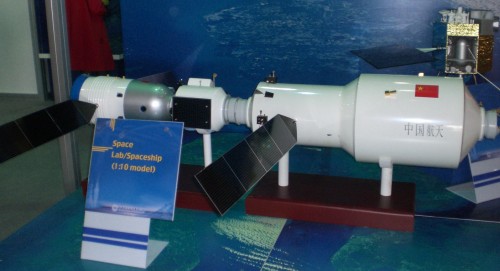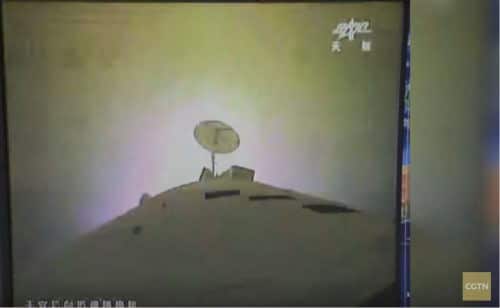A precise atomic clock, vegetables and rice that grow more slowly and other experiments conducted on the temporary space station, and will be implemented on the permanent Chinese space station planned to operate starting in 2022


The Chinese Tiangong 2 experimental space station entered the atmosphere in a controlled manner yesterday (Friday) and crashed into the spacecraft graveyard in the South Pacific Ocean. This is in contrast to its predecessor Tiangong
Tiangong 2 (literally "Heavenly Palace 2") was launched on September 15, 2016 aboard the Long March 2F launcher from the Jiuquan Spaceport in the Gobi Desert.
The purpose of the station was to test the technologies necessary to fulfill the goal of the Chinese space program to put into service an operational and modular space station around the year 2022. The main goals that will be tested during the station's mission are the ability to stay for a medium time in space and transfer supplies to the station and refueling in space by a cargo spaceship, to enable a long-term stay in space.
The station was equipped with 14 different scientific experiment packages including: a gamma-ray burst detector called POLAR built by scientists from China, Switzerland and Poland. An experiment in quantum encryption communication using the quantum key exchange method. The first cold atomic clock launched into space, and
An experiment in growing plants in space was, according to the Chinese, the highlight of the operation.
In October 2016, a manned team of two taikonauts was launched to the station in the Shenzhou 11 mission, which stayed at the station for 30 days with the aim of proving the ability to stay in space for a medium period of time.
Zheng Huiqiong, a researcher at the Institute of Plant Physiology and Ecology at the Chinese Academy of Sciences still remembers how she nervously waited for the astronauts in November 2016 to receive back a small box containing Arabidopsis thaliana, a type of vegetable, grown on Tiangong 2. As the chief scientist of the experiment, she was the first to see the plant taken out small flower "It was an exciting moment like no other," Zheng said.
Zheng's team sent seeds of Arabidopsis thaliana and rice to the station to allow them to complete the growth process from seeds and produce seeds in space – a first experiment of its kind carried out by Chinese scientists. From the small box returned by the astronauts, the team produced nine seeds.
"Tiangong-2's mission was the opportunity. Our first to perform a long-term plant experiment in space. This experiment is significant because growing grains and vegetables will be a necessity if humans want to leave the earth and survive a long-term flight in space," said Zheng. In an interview with the Chinese news agency Xinhua.
"We found that plants grow more slowly in space than on Earth and bloom later. However, they live longer in space than on Earth. The lifespan of Arabidopsis thaliana in space was about twice as long as on Earth. We believe that the genes associated with aging undergo a change in space, Zheng said.
"If we find the method to regulate the growth of plants, we can delay the flowering of vegetables to make them grow more leaves and speed up the flowering of rice to turn it into seed as soon as possible. Therefore, we can use the limited resources in space to maximize the yield. The research could also be applicable on Earth, Zheng said.
As mentioned, the two space stations so far, Tiangong 1 and 2, were a kind of preparation for the Chinese permanent space station, the construction of which is expected to be completed in 2022. The weight of the station is 66 tons, and it will be built in the shape of the letter T with the core module known as Tianhe in the center and a laboratory on each side.
The station, which will orbit the Earth at an altitude of 450-340 km, will be able to grow up to 180 tons and accommodate three to six astronauts. It is designed to operate for at least ten years, but it will be possible to extend its life through on-track maintenance.
The Tiangong-2 space station tested the first atomic clock ever in space, which was so accurate that it lost one second every thirty million years. It will have a far-reaching impact on deep space exploration, fundamental physics research and precision measurement, according to its developers from the Shanghai Institute of Optics and Fine Mechanics of the Chinese Academy of Sciences.
China's space station will carry a hydrogen clock, a cold atomic clock and an optical clock to enable high precision and frequency. The margin of error of the system will be less than one second every three billion years.
And as mentioned, a device known as POLAR developed by scientists from China, Switzerland and Poland was installed on Tiangong 2 in order to look for gamma ray bursts - the most powerful explosions in the universe. Scientists from China, Switzerland, Germany and Poland plan to continue their collaboration and develop POLAR-2 to be stationed on China's space station, which is expected to contribute to research on questions such as the formation of black holes.
China seeks to increase international cooperation in space station experiments to promote sustainable global development and cooperation. Nine scientific experiments involving 23 institutions from 17 countries have been accepted and will be carried out on China's space station.

One response
Hope the cooperation regarding the growing of the plants will be successful!